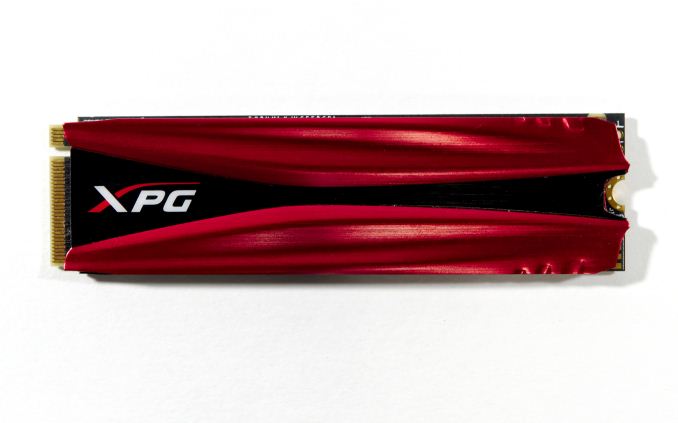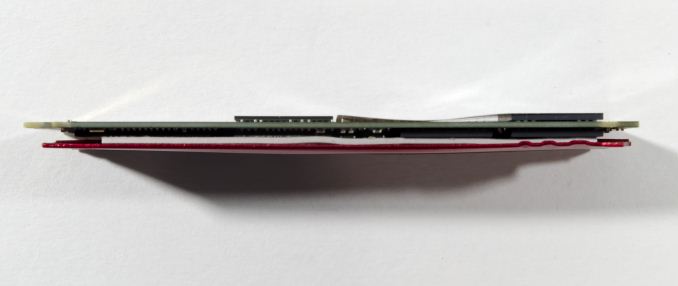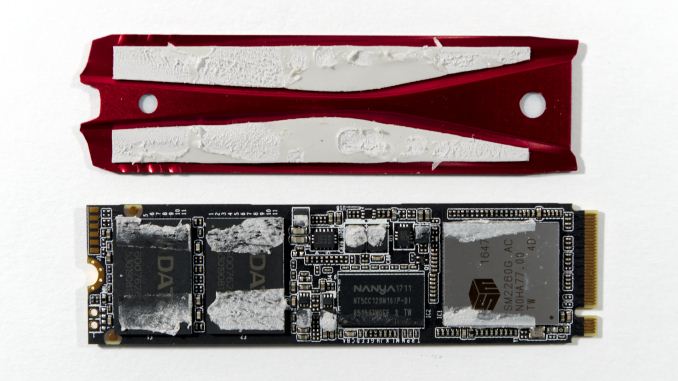The ADATA XPG GAMMIX S10 (512GB) SSD Review: Entry-Level NVMe With Style
by Billy Tallis on October 25, 2017 8:30 AM EST
The ADATA XPG GAMMIX S10 is a M.2 NVMe SSD with very enthusiast-oriented branding and packaging, but it isn't even close to being ADATA's top NVMe SSD. Instead, it's a derivative of their entry-level XPG SX7000 M.2 NVMe SSD, adding only a heatspreader. Underneath, the SX7000 and the GAMMIX S10 both use Micron 32-layer 3D TLC NAND with the Silicon Motion SM2260 controller. This combination is also used in the Intel SSD 600p, which has been one of the cheapest NVMe SSDs on the market.
The Silicon Motion SM2260 controller is their first NVMe SSD controller. SMI's initial aspirations for the controller were high, but it has instead found its niche as the cheap but slower option. The SM2260 was the first NVMe controller to offer a turnkey firmware solution for use with Intel/Micron 3D NAND. That allowed Silicon Motion to win back some market share from from Phison, whose controllers including the PS5007-E7 NVMe controller are largely tied to Toshiba NAND. This is an important distinction as Toshiba's 3D NAND has yet to make an appearance in any third-party SSDs. For SSD vendors that source both NAND and controllers on the open market, Silicon Motion and Micron have been the only 3D NAND option for the past year.
The Intel/Micron 32-layer 3D NAND flash memory was the second 3D NAND to ship in volume (after Samsung's V-NAND), and the first to be widely available on the open market, as Samsung uses most of their flash for their own SSDs. Micron's 3D NAND has proven to be slower than Samsung's, but reasonably power efficient when paired with the right controller. It is also fairly cost-effective, and SSDs with Intel/Micron 3D NAND have been dominating the value SSD market for more than a year.
A new generation of Silicon Motion NVMe controllers has been announced but is still months away from being ready to hit the shelves. The 64-layer Intel/Micron 3D NAND has seen a very limited release in the Intel 545s, but the flash used by the ADATA XPG GAMMIX S10 can't be replaced yet. Meanwhile, ADATA is now able to buy Micron's 32-layer 3D NAND by the wafer and do their own binning and packaging. As their top TLC SSD, the GAMMIX S10 is likely equipped with the highest grade of 3D NAND that goes into ADATA's consumer drives.
| ADATA XPG GAMMIX S10 Specifications | ||||
| Capacity | 128 GB | 256 GB | 512 GB | 1 TB |
| Model Number | ASX7000NPC- 128GT-C |
ASX7000NPC- 256GT-C |
ASX7000NPC- 512GT-C |
ASX7000NPC- 1TT-C |
| Controller | Silicon Motion SM2260 | |||
| NAND Flash | Micron 384Gb 32L 3D TLC NAND | |||
| Form-Factor, Interface | M.2-2280, PCIe 3.0 x4, NVMe 1.2 | |||
| Sequential Read | 660 MB/s | 1370 MB/s | 1750 MB/s | |
| Sequential Write | 450 MB/s | 820 MB/s | 860 MB/s | 850 MB/s |
| Random Read IOPS | 35K IOPS | 70K IOPS | 130K IOPS | |
| Random Write IOPS | 95K IOPS | 130K IOPS | 140K IOPS | |
| Warranty | 5 years | |||
| MTBF | 2,000,000 hours | |||
The specifications for the ADATA XPG GAMMIX S10 are typical for an entry-level NVMe SSD. The 128GB model has severely reduced performance potential due to not being able to populate every channel of the controller with NAND flash chips, while the 512GB and 1TB models offer about the same performance. Despite having a PCIe 3.0 x4 link that is capable of almost 4GB/s, the GAMMIX S10 won't even hit 2GB/s. ADATA doesn't officially list write endurance, but the five-year warranty is a step up from what most entry-level SSDs offer, even in the NVMe market segment.
The heatspreader on the ADATA XPG GAMMIX S10 keeps to a fairly low profile, but isn't just a single sheet of metal. The main body of the heatspreader is red, and there's a recessed section down the middle that holds a black insert. On the underside of the heatspreader, this leads to thermal compound only being used on the outer edges of the heatspreader, and it makes very little contact with the controller itself. This heatspreader isn't purely cosmetic, but it will cool the drive much less than a first glance suggests it should.
The GAMMIX S10 is a double-sided M.2 card, with some DRAM, NAND flash, and smaller components on the back. Smaller capacities than our 512GB sample may omit the DRAM package on the back.
This review will compare the 512GB ADATA XPG GAMMIX S10 against a variety of NVMe and SATA SSDs. The closest competitors are mostly other NVMe SSDs using TLC NAND, so those drives have been highlighted in the bar charts.
| AnandTech 2017 SSD Testbed | |
| CPU | Intel Xeon E3 1240 v5 |
| Motherboard | ASRock Fatal1ty E3V5 Performance Gaming/OC |
| Chipset | Intel C232 |
| Memory | 4x 8GB G.SKILL Ripjaws DDR4-2400 CL15 |
| Graphics | AMD Radeon HD 5450, 1920x1200@60Hz |
| Software | Windows 10 x64, version 1703 |
| Linux kernel version 4.12, fio version 2.21 | |
- Thanks to Intel for the Xeon E3 1240 v5 CPU
- Thanks to ASRock for the E3V5 Performance Gaming/OC
- Thanks to G.SKILL for the Ripjaws DDR4-2400 RAM
- Thanks to Corsair for the RM750 power supply, Carbide 200R case, and Hydro H60 CPU cooler












27 Comments
View All Comments
Flunk - Wednesday, October 25, 2017 - link
Even a proper heatspreader doesn't cool the underlying components, to do that you need fins to dissipate heat. Add fins to a heatspreader then you have a heatsink. I'm not saying heatspeaders are worthless, but they don't do much unless attached to something else.ddriver - Wednesday, October 25, 2017 - link
The heatspreader will work, if it has good contact with the chip, which it doesn't.The purpose of the heat spreader is ... well... to spread heat. This gives you more surface to displace heat. Fins serve to increase the head-spreading effect further, although for this product in particular I doubt fins are necessary. In fact, as I mentioned above, the way the heatspreader is implemented and the pathetic performance itself suggest that the cooling solution is 100% unneeded, and present purely for cosmetic purposes.
znd125 - Wednesday, October 25, 2017 - link
Information on the die/channel configuration is lacking in many SSD reviews by Billy Tallis. This information is especially important for SSDs using non-power-of-2 density NAND chips, which often result in awkward die/channel configurations that consequently lead to low performance. Tallis rarely discusses this.It is not enough to simply state "... severely reduced performance potential due to not being able to populate every channel of the controller with NAND flash chips". I expect more from AT articles. If not every, how many channels are populated? How many dies are in each channel? Are they evenly distributed? Tell us exactly how the channels are populated and then you can go on to judge whether that is good or bad.
As another example, Tom's Hardware in their Intel 600p review pointed out the drive was able to use only 6 of the 8 channels. Tallis did not. To me, that is not a trivial piece of information. That is THE reason the 600p does not reach its "performance potential" IMO.
Ratman6161 - Wednesday, October 25, 2017 - link
While I too would be interested to see the information you are seeking, I don't think its a critical flaw in the article. For those interested in making a buying decision, its the performance scores and the price and the price/performance equation that matter. Other information is useful if you want to know why one performs better than another. However, with nearly all SSD reviews these days, I usually end up just skimming through to the conclusion. If its a SATA drive, all I really want to know is where is its price/performance ration vs a Samsung 850 EVO. If its NVMe then the price/performance comparison is against the 960 EVO.However....here is something I really would like to see more of. When drives are tested I would like to see the same drive tested in different sizes...which is kind of getting into what you are talking about indirectly. For example, in all the charts you can see a pretty substantial difference between the 1TB and 250 GB 960 EVO's. It really would be nice to see a 512 GB in there. A drive that wins at 1 TB may not win at 512 GB. Unfortunately when I was buying the 512 is what was in my price range and I had to do some digging for information on that. THG actually did review all three sizes.
DanNeely - Wednesday, October 25, 2017 - link
Assuming the conclusion is right about next year's controllers being massively better than the current generation they can't get here soon enough. None of the controllers currently available to the down market OEMs are remotely competitive with samsung's last few generations of parts.MrSpadge - Sunday, October 29, 2017 - link
Adatas strategy seems to be: make many bad SSDs with fancy names and hope someones buys them by accident. Otherwise I can't explain this and the preceeding drives.